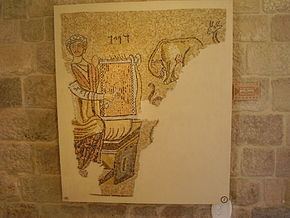Founded 508 AD Excavation date 1965 | Excavation dates 1965 | |
 | ||
Location Gaza, Palestinian territories Similar Katib al‑Wilaya Mosque, Gaza Mall, Gaza Baptist Church, Al Deira Hotel, Sayed al‑Hashim Mosque | ||
The ancient synagogue of Gaza was built in 508 AD during the Byzantine period and was discovered in 1965. It was located in the ancient port city of Gaza, then known as "Maiumas", currently the Rimal district of Gaza City.
Contents
4 years after the struggle against demolition of gaza synagogues
History
In 1965, Egyptian archaeologists discovered the site and announced they had uncovered a church. Later a mosaic of King David wearing a crown and playing a lyre, labelled in Hebrew, was found. The mosaic was dated to 508-09 CE and measured 3 meters (9.8 ft) high by 1.9 meters (6.2 ft) wide. It was originally described as depicting a female saint playing the harp. The Egyptian archaeologists stated that the mosaic was in fact a depiction of Orpheus, a Greek mythological figure who was commonly associated with David and used in Byzantine art. Shortly after the mosaic's discovery, David's face was gouged out. When Israel captured the Gaza Strip in the 1967 Six-Day War, the mosaic was transferred to the Israel Museum for restoration.
The mosaic floor of the synagogue is on show at the Museum of the Good Samaritan, located on the Jerusalem-Jericho Road near Ma'ale Adumim.
